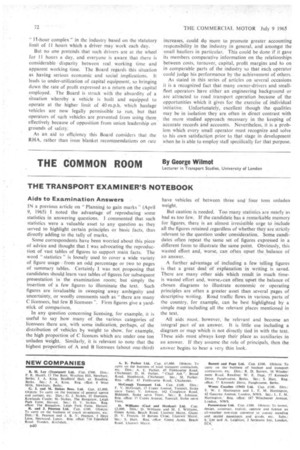THE COMMON ROOM
Page 74

If you've noticed an error in this article please click here to report it so we can fix it.
By George Wilmot
Lecturer in Transport Studies, University of London
THE TRANSPORT EXAMINER'S NOTEBOOK
Aids to Examination Answers
IN a previous article on "Planning to gain marks (April 9, 1965) I. noted the advantage of reproducing some statistics in answering questions. I commented that such statistics were a valuable asset to any question as they served to highlight certain principles or basic facts, thus directly adding to the tally of marks.
Some correspondents have been worried about this piece of advice and thought that I was advocating the reproductiori of vast tables of figures to support main facts. The word statistics" is loosely used to cover a wide variety of figure usage'--from an odd percentage or two to pages of summary tables. Certainly I was not proposing that candidates should learn vast tables of figures for subsequent presentation in the examination room; but simply the insertion of a few figures to illuminate the text. Such figures are invaluable in sweeping away ambiguity and uncertainty, or woolly comments such as there are many C licensees, but few B licensees -. Firm figures give a yardstick of comparison.
In any question concerning licensing, for example, it is useful to say how many of. the various categories of licensees there are, with some indication, perhaps, of the distribution of vehicles by weight to show, for example, the high proportion of C licences which are under one ton unladen weight. Similarly, it is relevant to note that the highest proportion of A and B licensees (about one-third) have vehicles of between three and four tons unladen weight.
But caution is needed. Too many statistics are nearly as bad as too few. If the candidate has a remarkable memory for figures, there is an almost irresistible urge to include all the figures retained regardless of whether they are strictly relevant to the question under consideration, Some candidates often repeat the same set of figures expressed in a different form to illustrate the same point. Obviously, this wasted effort and, worse, can often upset the balance of an answer.
A further advantage of including a few telling figures is that a great deal of explanation in writing is saved. There are many other aids which result in much timeis wasted effort and. worse,-.can often upset the balance of chosen diagrams to illustrate economic or operating principles are often a greater asset than several pages of descriptive writing. Road traffic flows in various parts of the country. for example, can he best highlighted by a simple map including all the relevant places mentioned in the text.
All aids must, however, be relevant and become an integral part of an answer. It is little use including a diagram or map which is not directly tied in with the text. These aids must always keep their place as auxiliaries in an answer. If they assume the role of principals, then the answer begins to bear a very thin look.




















































































































